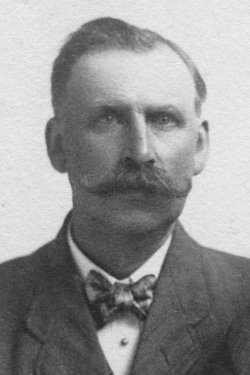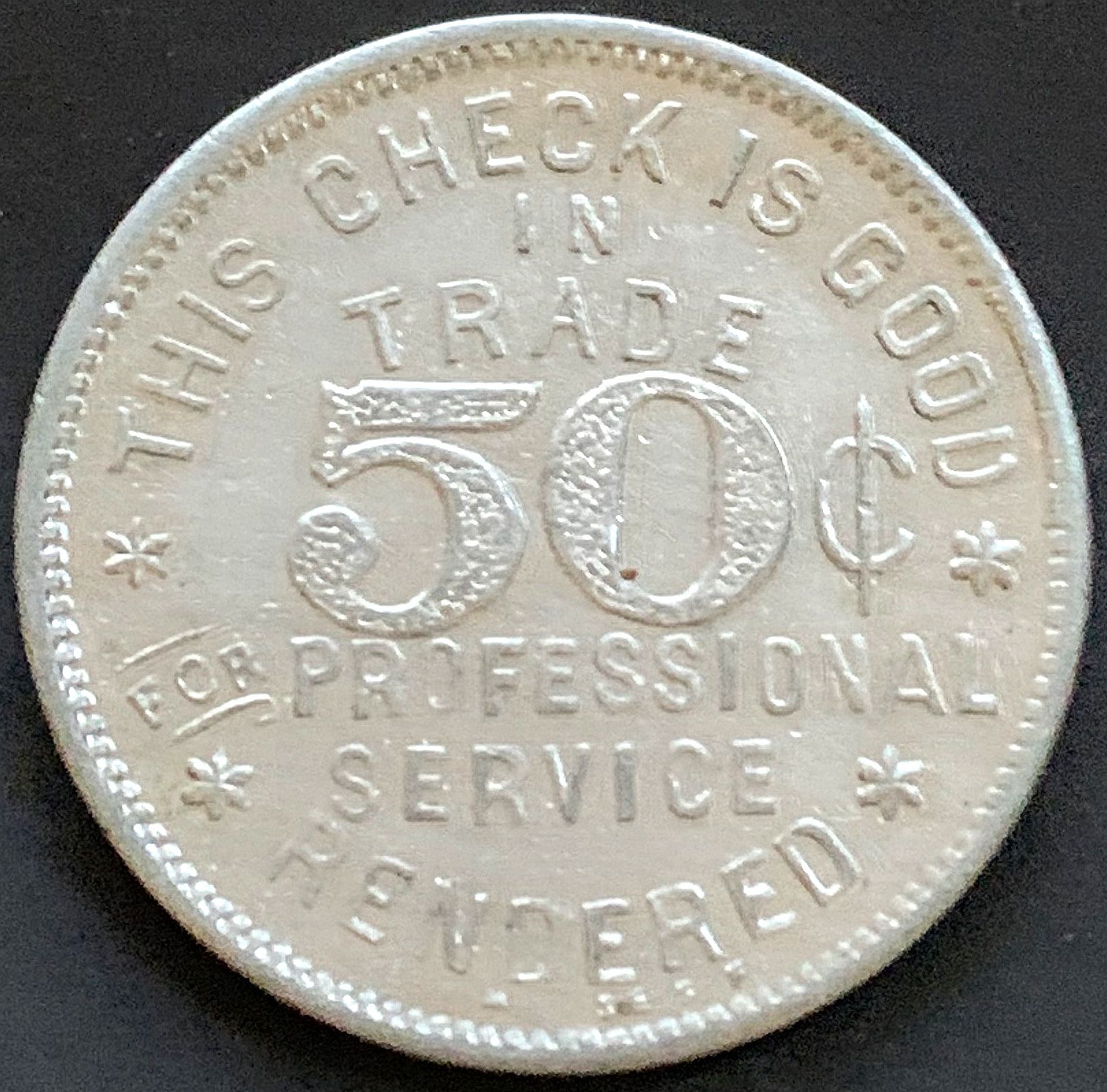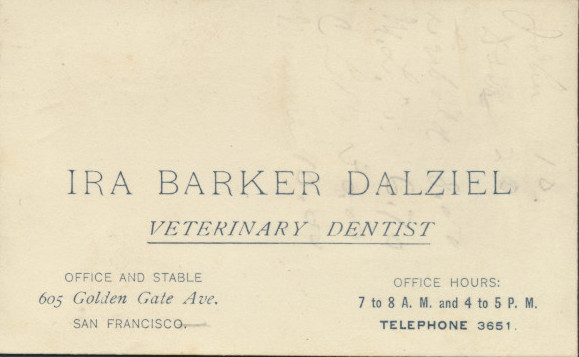Under the name Ira Baker Dalziel we find the following:
Lindsay Mills, fifty-three, of Pomona, Calif., and Dr. Ira Baker Dalziel, eighty-four, of Redwood City. Calif., both died at their homes recently.
Any one, whose custom was to visit the barns at the Santa Anita track in the mornings during the meeting when the barns housed many thoroughbreds, or at Pomona, California, during the Los Angeles County Fair, or for that matter, practically any race track from Bay Meadows to Caliente, will recall seeing a busy old gentleman carrying a black grip, and wearing a big hat from under which peered a pair of sharp youthful eyes. A long white mustache was also a part of the human picture. On first seeing him people were impressed at once by his kindly smile. A pair of unusually broad shoulders, caused people to remark how well―preserved was this old gentleman. He was more than six feet fall, walked unusually straight, regardless of his years. Then some scrawny exercise boy, or fat driver would proudly inform them that they were looking at "Doc" Dalziel, "the best equine dentist that ever floated a horse's tooth."
He seemed to belong to California, even though a native of the state of Maine, and was regarded as a fixture of the California Circuit. And, after all, why shouldn't he be held in high regard? He had been the state's foremost horse dentist for over fifty years, besides being loved by every saddle horse trainer, jockey and driver of the west coast. Not only because you considered him one of your best and most trusted friends, Dr. Dalziel was an expert of experts in the equine dental profession.
It is said of him that he has worked on every horse from Seabiscuit to Star Pointer during his long career. He had done dental work for the Vanderbilts, Whitneys, Calumet Farm, Scripps, Cowell, the old Carnation saddlers, and the whole line.
Twenty-three years ago, he was associated with the chair of Veterinary Dentistry in the Veterinary School of the, University of California, regarded as one of the best operators in the entire country.
Dr. Joseph Arburua (1894-1972, FAG Memorial# 107967334) had this observation on formal veterinary education and state licentiates in his book on the history of veterinary medicine in California (Arburua, J.M. DVM. Narrative of the Veterinary Profession in California. San Francisco: 1966, page 65): An interesting case was that of a San Francisco horse-breaker, who practiced equine dentistry for some 40 years unmolested. He attended the San Francisco college about the turn of the century, having already practiced illegally for several years. Dentistry was a first-year subject and at the termination of that year, if qualified, the student was given a certificate in veterinary dentistry. This was standard procedure in many, if not all, veterinary schools of the era. It was discontinued in the San Francisco college in 1912; thus at the end of my freshman year in 1913, I was a year too late to receive such a testimonial. After his first year at school, our hero left his alma mater armed with his certificate, his academic role having been reached. He proceeded to practice equine dentistry for the rest of his life. He was a veritable artist in the field, and an acknowledged authority. He became widely known, and was called to every section of the United States to treat the finest horses in the land. In the later 30's, a comparatively recent graduate resented this man’s flouting of constituted authority and apparent immunity, and made every effort to persuade the veterinarians to prosecute him. The dentist was at this time favorably known and highly respected among race-horse owners, and was, in addition, about 80years old. The elders of the profession were against any legal action, believing that it would only cause adverse publicity; also time would soon remove the thorn. He continued to practice with impunity until his death.
Dr. Arburua was without doubt referring to Ira Barker Dalziel.
Under the name Ira Baker Dalziel we find the following:
Lindsay Mills, fifty-three, of Pomona, Calif., and Dr. Ira Baker Dalziel, eighty-four, of Redwood City. Calif., both died at their homes recently.
Any one, whose custom was to visit the barns at the Santa Anita track in the mornings during the meeting when the barns housed many thoroughbreds, or at Pomona, California, during the Los Angeles County Fair, or for that matter, practically any race track from Bay Meadows to Caliente, will recall seeing a busy old gentleman carrying a black grip, and wearing a big hat from under which peered a pair of sharp youthful eyes. A long white mustache was also a part of the human picture. On first seeing him people were impressed at once by his kindly smile. A pair of unusually broad shoulders, caused people to remark how well―preserved was this old gentleman. He was more than six feet fall, walked unusually straight, regardless of his years. Then some scrawny exercise boy, or fat driver would proudly inform them that they were looking at "Doc" Dalziel, "the best equine dentist that ever floated a horse's tooth."
He seemed to belong to California, even though a native of the state of Maine, and was regarded as a fixture of the California Circuit. And, after all, why shouldn't he be held in high regard? He had been the state's foremost horse dentist for over fifty years, besides being loved by every saddle horse trainer, jockey and driver of the west coast. Not only because you considered him one of your best and most trusted friends, Dr. Dalziel was an expert of experts in the equine dental profession.
It is said of him that he has worked on every horse from Seabiscuit to Star Pointer during his long career. He had done dental work for the Vanderbilts, Whitneys, Calumet Farm, Scripps, Cowell, the old Carnation saddlers, and the whole line.
Twenty-three years ago, he was associated with the chair of Veterinary Dentistry in the Veterinary School of the, University of California, regarded as one of the best operators in the entire country.
Dr. Joseph Arburua (1894-1972, FAG Memorial# 107967334) had this observation on formal veterinary education and state licentiates in his book on the history of veterinary medicine in California (Arburua, J.M. DVM. Narrative of the Veterinary Profession in California. San Francisco: 1966, page 65): An interesting case was that of a San Francisco horse-breaker, who practiced equine dentistry for some 40 years unmolested. He attended the San Francisco college about the turn of the century, having already practiced illegally for several years. Dentistry was a first-year subject and at the termination of that year, if qualified, the student was given a certificate in veterinary dentistry. This was standard procedure in many, if not all, veterinary schools of the era. It was discontinued in the San Francisco college in 1912; thus at the end of my freshman year in 1913, I was a year too late to receive such a testimonial. After his first year at school, our hero left his alma mater armed with his certificate, his academic role having been reached. He proceeded to practice equine dentistry for the rest of his life. He was a veritable artist in the field, and an acknowledged authority. He became widely known, and was called to every section of the United States to treat the finest horses in the land. In the later 30's, a comparatively recent graduate resented this man’s flouting of constituted authority and apparent immunity, and made every effort to persuade the veterinarians to prosecute him. The dentist was at this time favorably known and highly respected among race-horse owners, and was, in addition, about 80years old. The elders of the profession were against any legal action, believing that it would only cause adverse publicity; also time would soon remove the thorn. He continued to practice with impunity until his death.
Dr. Arburua was without doubt referring to Ira Barker Dalziel.














